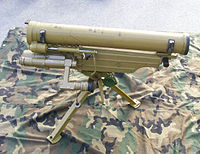9K115 Metis
| 9K115 Metis | |
|---|---|
 NATO reporting name: AT-7 Saxhorn | |
| Type | Anti-tank missile |
| Place of origin | Soviet Union |
| Service history | |
| In service | 1979 – present |
| Used by | Russia |
| Production history | |
| Manufacturer | KBP Instrument Design Bureau |
| Produced | 1978 – present |
| Variants | 9K115-2 Metis-M |
| Specifications | |
| Mass | 5.5 kg (12 lb); 6.3 kg (14 lb) w/container |
| Length | 740 mm (29 in) |
| Diameter | 94 mm (4 in) |
| Wingspan | 300 mm (12 in) |
| Warhead | HEAT shaped charge |
| Warhead weight | 2.5 kg (5.5 lb) |
Operational range | 40–1,000 m (130–3,280 ft) |
| Maximum speed | 223 m/s (732 ft/s) |
Guidance system | Wire-guided SACLOS |
The 9K115 Metis ("mongrel") (NATO reporting name AT-7 Saxhorn) is a man-portable SACLOS wire-guided anti-tank missile system of the Soviet Union.
Development
The missile was developed by the Tula KBP. It is very similar to the AT-4 Spigot in external appearance (having three main fins); however, the missile is much lighter - primarily because of the reduced fuel load, which reduces the maximum range to 1,000 metres (3,300 ft).
During the 1980s, an upgraded version of the missile was developed - the Metis-M 9M131 (sometimes labelled Metis-2). Fired from the same launcher, the new missile is much larger and heavier, with an increased range and a larger warhead. NATO labelled this missile the AT-13 Saxhorn-2.
History
The missile was introduced into the Russian army in 1979 to supplement the AT-4 Spigot at company level. The system is lighter than the AT-4 Spigot system, due to a less complicated tripod launcher and a lighter missile.
In Russian service, the AT-7 is deployed with motor rifle companies, with three launchers per company. The missile is operated by a two-man team; the gunner carries the 9P151 launching post and one missile, his assistant carries an additional three missiles.
The export prices of the missile and firing post in 1992 were:
- 9M131 Missile $13,500
- 9P151 Firing post $70,000
Models
- AT-7 Saxhorn - Entered service in 1979.
- AT-13 Saxhorn-2 - 9K115-2 Metis-M
Description
The missile is fired from the 9P151 launching post, which has a simple tripod for support. It can also be fired from the shoulder - but this apparently requires more skill on the part of the operator. The launching post weighs 10.2 kilograms (22 lb). The missile is launched from the tube by a booster rather than the gas generator used on the AT-4 Spigot system, despite both missiles being designed by the same design bureau. The 9S816 guidance system is powered by a thermal battery attached to the launch tube shortly before launch - the missile itself is remotely powered along the guidance wires.
The missile can be launched from an enclosed space, such as a building or cave, but requires at least 6 metres (20 ft) behind the launcher, and a total internal volume of at least 100 cubic metres (3,500 cu ft). The missile has a short minimum range of 40 metres (130 ft) and can engage targets moving at up to 60 kilometres per hour (37 mph).
The missile's warhead is a single HEAT shaped charge.
Operators


Current operators
Former operators
 Poland - Retired.
Poland - Retired.
See also
References
This article includes a list of references, related reading, or external links, but its sources remain unclear because it lacks inline citations. (November 2014) |
- Hull, A.W., Markov, D.R., Zaloga, S.J. (1999). Soviet/Russian Armor and Artillery Design Practices 1945 to Present. Darlington Productions. ISBN 1-892848-01-5.
